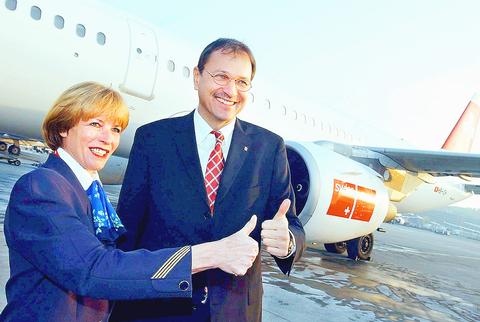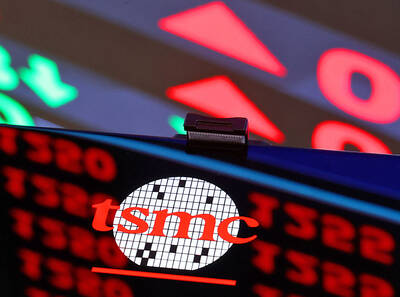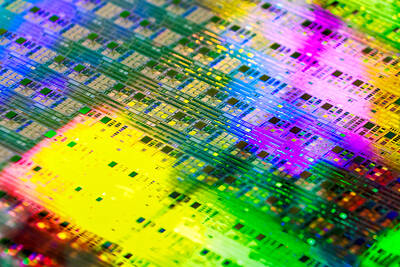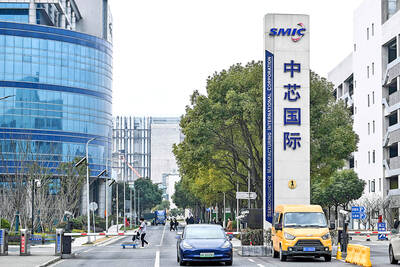Crossair AG took off yesterday as Switzerland's new flag carrier after adding 52 planes to its fleet from Swissair Group, the former national airline that filed for bankruptcy protection in October.
The airline is backed by the country's biggest companies including UBS AG, Nestle SA and Novartis AG, federal and regional governments and wealthy individuals, who together invested SF4.2 billion (US$3.3 billion) in the project. Switzerland's biggest-ever corporate failure had threatened tens of thousands of jobs and the country's reputation for quality and reliability.

PHOTO: AP
In six months, Chief Executive Officer Andre Dose, 44, has doubled the size of Crossair's staff, renegotiated cheaper leases for the planes and cut Swissair pilots' pay by a third to increase the airline's chances of making a profit. Even so, the Basel-based carrier will struggle to make money, analysts said.
"There's a reasonable chance it will survive over the next 12 to 24 months," said Anthony Bor, an analyst at Merrill Lynch & Co. "The chances of survival beyond the medium term in its current form are limited. This is not a business I'd invest in."
Crossair's plan to operate 26 long-haul and 102 short-haul aircraft from Switzerland, with a domestic market of only 7.2 million people, means the airline is too dependent on transfer passengers to fill the planes, Bor said.
To overcome that handicap, Dose wants to join the Oneworld alliance to sell tickets to other airlines' passengers. The size of Crossair's fleet is holding up negotiations as potential partners fear Crossair may steal too many customers.
The fleet includes Boeing Co MD-11 and Airbus SAS A330 planes from Swissair, adding to its own mix of 76 Boeing, Saab AB, BAE Systems Plc and Empresa Brasileira de Aeronautica SA jets. It will be simplified to 52 Airbus and 82 Embraer by 2005.
The carrier, whose planes will fly under the brand name "Swiss," also has a marketing problem linked to Swissair's collapse, analysts said. At the time, the airline grounded its fleet for two days, leaving tens of thousands of passengers stranded at airports around the world. Zurich airport opened nuclear-war fallout shelters as makeshift hotel rooms.
It's a particular risk given the airline's ambition of running the best first, business and economy classes in the industry, analysts said.
The brand concept is based on the idea that Swiss is "accepted shorthand for excellence around the world," said Tyler Brule, editor of London-based lifestyle magazine Wallpaper, who was hired to oversee the redesign.
"The challenge is to create a quality airline and make it profitable," said Patrik Schwendimann, an analyst at Zuercher Kantonalbank. "Often these are opposites. The critical question is what premium passengers are willing to pay for a quality airline ticket."
Crossair expects to post a loss of SF1.1 billion this year on the cost of taking over Swissair's planes, renaming itself Swiss Air Lines Ltd later in the year and changing its corporate identity. It aims to be profitable in 2003.
The loss could be smaller if business continues as it has in the first two months of the year, Dose said in an interview, because Crossair has been carrying more passengers than set out in the business plan approved by its investors.
Air traffic has recovered faster than expected after the terrorist hijackings Sept. 11. European airlines' international traffic fell 3.8 percent in the week through March 17, after falling by as much as a third after the attacks.
Even so, Dose, who became CEO a year ago after a decade as deputy head of flight operations, said he never doubted the validity of the plan to take two-thirds of Swissair's fleet. He drafted it in May after the national carrier that controlled Crossair posted its worst-ever loss in the previous month.
"It's the ideal size," he said. "If you don't do it, then you'd have to stop flying in Switzerland altogether because this is what makes the most sense economically."
The success of the plan so far has made Dose into a public figure in Switzerland. He can't buy a newspaper or eat out without being accosted by people, and receives phone calls and letters at home, he said.
It's an unusual status in a country where film stars and royalty can spend their holidays without drawing a crowd, and government ministers walk unaccompanied to their offices in Bern.
Dose said he's worked 16 to 18-hour days for five months to prove his plan will work. The same determination marked the start of his career, when he worked night shifts as a 16-year-old schoolboy to pay for flying lessons.
"I'm by nature someone who doesn't get overstressed," he said. "Actually, the more problems I have on my back, the quieter and the more focused I get."

SEMICONDUCTOR SERVICES: A company executive said that Taiwanese firms must think about how to participate in global supply chains and lift their competitiveness Taiwan Semiconductor Manufacturing Co (TSMC, 台積電) yesterday said it expects to launch its first multifunctional service center in Pingtung County in the middle of 2027, in a bid to foster a resilient high-tech facility construction ecosystem. TSMC broached the idea of creating a center two or three years ago when it started building new manufacturing capacity in the US and Japan, the company said. The center, dubbed an “ecosystem park,” would assist local manufacturing facility construction partners to upgrade their capabilities and secure more deals from other global chipmakers such as Intel Corp, Micron Technology Inc and Infineon Technologies AG, TSMC said. It

NO BREAKTHROUGH? More substantial ‘deliverables,’ such as tariff reductions, would likely be saved for a meeting between Trump and Xi later this year, a trade expert said China launched two probes targeting the US semiconductor sector on Saturday ahead of talks between the two nations in Spain this week on trade, national security and the ownership of social media platform TikTok. China’s Ministry of Commerce announced an anti-dumping investigation into certain analog integrated circuits (ICs) imported from the US. The investigation is to target some commodity interface ICs and gate driver ICs, which are commonly made by US companies such as Texas Instruments Inc and ON Semiconductor Corp. The ministry also announced an anti-discrimination probe into US measures against China’s chip sector. US measures such as export curbs and tariffs

The US on Friday penalized two Chinese firms that acquired US chipmaking equipment for China’s top chipmaker, Semiconductor Manufacturing International Corp (SMIC, 中芯國際), including them among 32 entities that were added to the US Department of Commerce’s restricted trade list, a US government posting showed. Twenty-three of the 32 are in China. GMC Semiconductor Technology (Wuxi) Co (吉姆西半導體科技) and Jicun Semiconductor Technology (Shanghai) Co (吉存半導體科技) were placed on the list, formally known as the Entity List, for acquiring equipment for SMIC Northern Integrated Circuit Manufacturing (Beijing) Corp (中芯北方積體電路) and Semiconductor Manufacturing International (Beijing) Corp (中芯北京), the US Federal Register posting said. The

India’s ban of online money-based games could drive addicts to unregulated apps and offshore platforms that pose new financial and social risks, fantasy-sports gaming experts say. Indian Prime Minister Narendra Modi’s government banned real-money online games late last month, citing financial losses and addiction, leading to a shutdown of many apps offering paid fantasy cricket, rummy and poker games. “Many will move to offshore platforms, because of the addictive nature — they will find alternate means to get that dopamine hit,” said Viren Hemrajani, a Mumbai-based fantasy cricket analyst. “It [also] leads to fraud and scams, because everything is now